Reply To:
Name - Reply Comment
Last Updated : 2024-04-26 22:10:00
Rabindra Jayanti is an annually celebrated cultural festival, prevalent mostly among Bengalis and lovers of art worldwide, to mark the birth anniversary of Indian Poet and Nobel Laureate Rabindranath Tagore. In Sri Lanka Tagore’s 156th birth anniversary was marked by a commemoration event held at the main library of the Colombo University. The event organized by the Colombo University’s Centre for Contemporary Indian Studies in collaboration with the Indian Cultural Centre on May 8 was graced by Indian High Commissioner Taranjit Singh Sandhu, the Colombo University Vice Chancellor Lakshman Dissanayake and faculty members including Prof. Sandagomi Coparahewa. At this event Rabindranath Tagore’s bust was garlanded by the High Commissioner while floral tributes were paid by the distinguished guests.
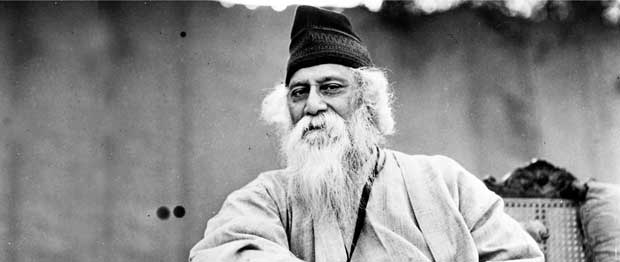
His short stories such as ‘Kabulwala’ have been translated into several languages and have found their way into the curriculum of literary studies across the world, including Sri Lanka
Tagore’s influence in literary and musical culture across Asia is undoubtedly far-reaching. Although known mostly for his poetry, Tagore also penned novels, essays, travelogues and more than a thousand songs. His notable works such as ‘Chandalika’ and ‘Valmiki Pratibha’ were the first of their kind in this part of the hemisphere with its extended monologues, thickened and intricate sub-plots exploring philosophical narratives. His short stories such as ‘Kabulwala’ have been translated into several languages and have found their way into the curriculum of literary studies across the world, including Sri Lanka. Kabulwala or the fruit seller from Kabul is a story of a Pathan merchant who has come to Calcutta to find work and sells fruit for a living. In the midst of his travails he befriends a five-year-old girl in Calcutta who reminds him of his own daughter back in Kabul. The soft nuances of seemingly guiltless plots such as these were one of Tagore’s many literary attributes.
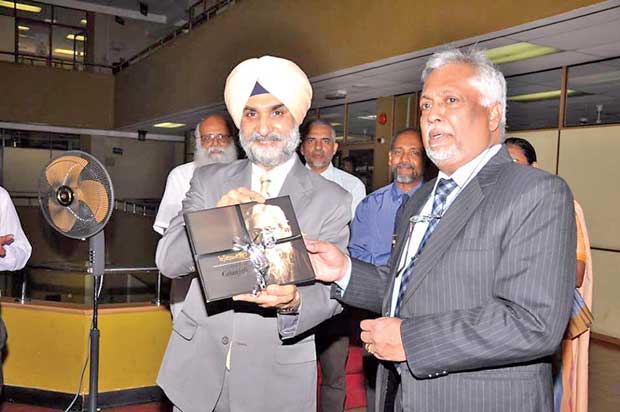 High Commissioner Sandhu and Vice Chancellor Lakshman Dissanayake
High Commissioner Sandhu and Vice Chancellor Lakshman Dissanayake
Tagore’s most notable collection of prose, ‘Gitanjali’ or song offerings was published in 1912 with an introduction from Irish poet William Butler Yeats. Yeats himself a pillar of Irish and British literary establishments could not seem to contain his awe and reverence for the enigma that was Tagore as is evident in his introduction to Gitanjali. He said, “We have other poets, but none that are his equal. We call this the epoch of Rabindranath. No poet seems to me as famous in Europe as he is among us. He is as great in music as in poetry and his songs are sung from the West of India into Burma wherever Bengali is spoken.” It is apparent that Yeats was as enthralled as he was with the ‘completeness’ that is Tagore and was seemingly unaware of the developments a little south of India.
Samarakoon was a student at Tagore’s Viswa Bharati University, Shanti Niketan in India. Influenced by Tagore he returned to Sri Lanka after several months, changed his name to Ananda Samarakoon and embraced Buddhism
Tagore’s influence could hardly be contained as he was in amazement with life as much as life was deliberated by him. According to Prof. Sandagomi Copeahewa, who writes in his paper titled “Tagore’s visits to Sri Lanka, among the many aspects of Tagore’s diverse personality was his fascination for travel.
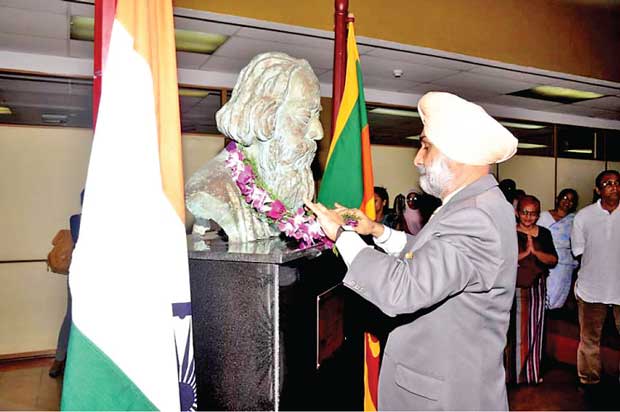 High Commissioner Sandhu pays tribute to Guru Dev Tagore
High Commissioner Sandhu pays tribute to Guru Dev Tagore
“He kept his doors open to ideas from the East and the West, carrying a message of truth and love. Tagore visited more than a third of the countries in the world including Sri Lanka. In fact, his last overseas visit was to Sri Lanka. During his travels, Tagore explained his ideal of Visva Bharati and raised funds for its development and made a deep impact on the cultural life of the people,” Coperahewa said.
Attempting to discuss Tagore’s impact on Sri Lankan culture by examining ways Tagore interacted with the cultural personalities of that era, Coparahewa concludes that Rabindranath Tagore was the greatest foreign influence on Sri Lankan arts and culture in the twentieth century. He arrives at this conclusion taking into consideration Tagore’s great interest in the Sri Lankan people and his emotional attachment with Lankan history.
According to scholars Tagore’s fascination with Sri Lankan seems to have been prompted by two factors: First the general belief that the Sinhalese -- the majority of Sri Lankans descended from immigrants from Bengal
Tagore was opposed to Imperialism and a vocal supporter of Indian nationalism. First revealed in his composition ‘Manast’ he urged masses to escape the victimology and seek education and dependence upon self. Although it attracted initial criticism, in a British-controlled South Asia, he maintained that even for those in the extremes of poverty there can be no question of blind revolution. He preferred purposeful education instead, emboldened in his ideology of establishing Shanti Niketan.
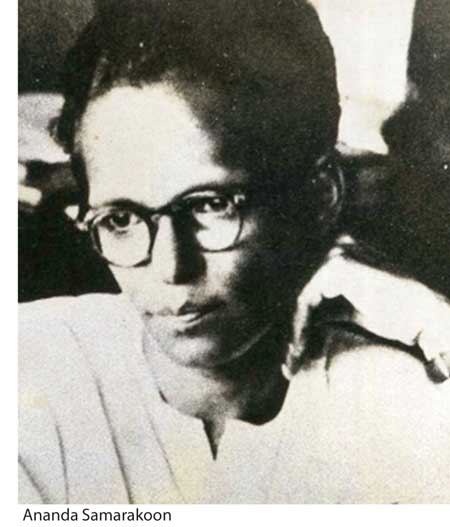
Given this backdrop it comes as no surprise that the Sri Lankan national anthem too was a product guided by Tagore’s influence. One of the most notable features of Tagore’s influence would be his awestruck admirers. His multi-faceted genius displayed across his body of work in prose, music and also his philosophy of re-building lost glory of his nation, left us with the likes of Ananda Samarakoon. Egodagahage George Wilfred Alwis Samarakoon was a student at Tagore’s Viswa Bharati University, Shanti Niketan in India. Influenced by Tagore he returned to Sri Lanka after several months, changed his name to Ananda Samarakoon and embraced Buddhism.
Upon his return to Mahinda College as an educator, Samarakoon wrote the now immortalized ‘Namo Namo Matha’ and taught it to his students. Although not envisioned as a nomination for Ceylon’s new national anthem, it was formally adopted in 1951. From this point onward, Sri Lankan history depicts a rather tragic fate for the creator of our national anthem. Ensued in controversy the national anthem was changed because of an ill perceived ‘gana’ sequence sans Samarakoon’s consent. The trifling query charge to tarnish Samarakoon’s story was that the inauspicious ‘gana’ had an effect on Ceylon’s various misfortunes leaving Samarakoon oppressed with shattered spirit. Perhaps the events that unfolded were the only barriers before a flourishing nation Ceylon; a story of what could have been, had it been guided by the inspirational minds like that of Tagore.
query charge to tarnish Samarakoon’s story was that the inauspicious ‘gana’ had an effect on Ceylon’s various misfortunes leaving Samarakoon oppressed with shattered spirit. Perhaps the events that unfolded were the only barriers before a flourishing nation Ceylon; a story of what could have been, had it been guided by the inspirational minds like that of Tagore.
‘Chetto jetha bhoyoshunyo’ is one of Tagore’s politically charged compositions, prior to India’s independence, conveying his vision of an awakened country. It appeared as poem No: 35 in Gitanjali, Tagore’s Nobel Prize winning collection of prose published in 1912.
His words immediately resonated in a South Asia chained by servitude to colonial masters. His call to awaken was carried far and wide through song and prose. Tagore himself recited the poem translated into English titled ‘Indian Prayer’ at the Indian National Congress session in Calcutta. His call to strike a sleeping nation with no mercy struck Sri Lanka’s Mahagama Sekara who translated it as ‘Mage deshaya awadikaranumena, piyaneni’ immortalized with the vocals of Pandit Amaradeva.
Tagore’s sentiments were carried across the world by many who were in awe of his persona and shared his vision. According to scholars Tagore’s fascination with Sri Lankan seems to have been prompted by two factors: First the general belief that the Sinhalese -- the majority of Sri Lankans descended from immigrants from Bengal and the second, a profound respect for Theravada Buddhism and the Buddhist heritage of the island. (Dharmadasa, 2011:2)
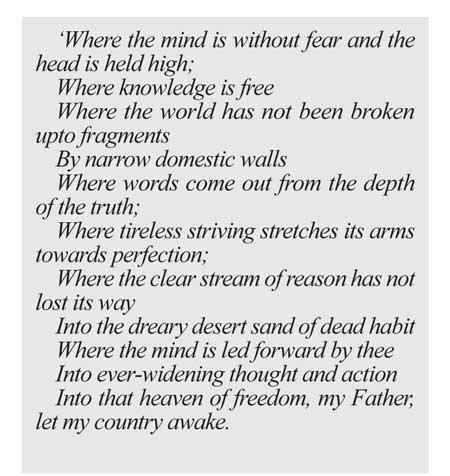
The enthusiasm created by Tagore’s visits to Sri Lanka was manifest in the formation of the Lanka Gandharva Sabha and the Tagore Society of Ceylon, established by his students at Shanti Niketan and Tagore’s admirers. His was the influence when oriental music was introduced to the Lankan curriculum in 1944, a breakthrough in Lankan education curriculum in its formative years. According to the activities of the youth who followed the light of Tagore at Shanti Niketan is the best way of assessing Tagore’s level of influence. These youth would include not only Samarakoon, but the likes of Ediriweera Sarachchandra, Sunil Shantha, Edwin Samaradiwakara and Chitrasena to name a few. They channelled the teachings of Tagore for the revival of Sri Lankan folk music, dance and drama, influenced by Rabindrasangeet. The first monk to be enrolled as a faculty member of the University of Ceylon the Rev. Udakendawala Saranankara was a social reformer inspired by the poet.
During one of Tagore’s visits to Colombo in 1934, he said ‘As a poet, it is my passion to restore that ancient association of mind through my efforts that speak through a direct language of art.’ It is our fervent hope that his vision lives on in the minds of kindred spirits in the years to come.

Add comment
Comments will be edited (grammar, spelling and slang) and authorized at the discretion of Daily Mirror online. The website also has the right not to publish selected comments.
Reply To:
Name - Reply Comment
US authorities are currently reviewing the manifest of every cargo aboard MV
On March 26, a couple arriving from Thailand was arrested with 88 live animal
According to villagers from Naula-Moragolla out of 105 families 80 can afford
Is the situation in Sri Lanka so grim that locals harbour hope that they coul

4 hours ago
6 hours ago